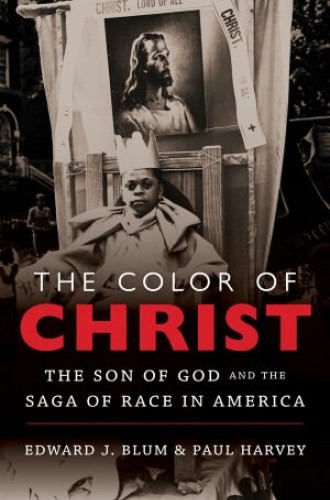Jesus in black and white
The Color of Christ confronts the complicated history of the Christ image and racial politics in the United States. The authors’ ambitious—some might say audacious—aim is to track “the creating and exercise of racial and religious power through the images of Jesus and how that power has been experienced by everyday people.” Their professed task is tantamount to telling the story of American Christianity in its manifold manifestations and interpretations across four centuries. In this bold project, Edward J. Blum and Paul Harvey have produced a rich and readable narrative that begins with the Puritans and concludes with Jesus in the age of Obama.
Blum and Harvey are two of the more productive chroniclers of American religion on the scene today. The duo has collaborated as coeditors of The Columbia Guide to Religion in American History (2012), as well as on the Religion in American History blog, where Harvey is editor. As historians who specialize in the southern region of the United States at the dawn of the 20th century, they have helped to advance the field of U.S. religious history in both print and digital media.
Read our latest issue or browse back issues.
Readers familiar with Stephen Prothero’s book American Jesus will recognize the narrative arc of The Color of Christ, but the two volumes should not be confused. Blum and Harvey’s diachronic account of the changing face of the Christ figure demonstrates an impressive collection of data, which includes artwork, sermons, music and personal testimonies. They present a dizzying number of illustrations from about seven historical epochs. In the process, we learn how people of faith—most notably white and black Protestants, white Mormons, Native Americans and European Catholic immigrants—rejected, embraced and interpreted the sacred Christ image across religious, racial and class lines.
For instance, the iconoclasm of Protestant colonists clashed with French and Spanish Catholic iconography in the 17th century. During the Revolutionary era, the founders kept Jesus at bay in favor of deist philosophy while enslaved African Americans and subjugated Native Americans were “making the Son of God a son of liberty.” And beginning in the 19th century, according to the authors, hypercommodified constructions of a masculine, de-Semitized white Jesus pervaded the culture.
Jesus was everywhere and on everyone’s side. Northern abolitionists envisaged Jesus as a courageous, freedom-fighting martyr in the vein of John Brown, the raider of Harpers Ferry. Post–Civil War southerners wrapped Jesus in the Confederate flag and their lost cause. Persecuted Mormons affirmed the sacrality of Jesus’ whiteness, along with their own, as a means of joining a perceived American mainstream that exalted white skin. Jesus intermeshed with a Paiute religious leader named Wovoka in the Southwest, encouraging the Ghost Dance movement. And everyone, from government officials to denominational mission boards, deployed Jesus as the face of American empire, an imperialistic totem that could redeem the lost, colored children of the world.
Even when Jesus sided with peoples of color, this does not mean that they believed the Christ looked like them. The rare instances of ethnic identification by blacks and Indians could hardly counter the cultural power and white supremacist logic that bolstered Jesus’ image in American society. Blum and Harvey go to great lengths to demonstrate that prevailing conceptions of a Nordic Christ were not easily disrupted. It was not just that few communities of color had the mass production capacity or consumer power to create a counterimage to William Pendleton’s Letter from Publius Lentulus or James Tissot’s The Life of Our Savior Jesus Christ. Rather, despite the white supremacist connotations of an Anglo Savior, a range of groups, from Cherokee Indians in the Southeast to African-American denominational leaders in the Northeast, embraced this white Jesus and even reimagined him as an ally.
There is much to appreciate in The Color of Christ. The book is replete with details about Jesus’ many iterations in the American psyche, and it is sure to inform all who are curious about how and why this Palestinian Jew from 2,000 years ago remains such a racial lightning rod in the Americas.
That said, one wonders if at times Blum and Harvey are more committed to disrupting what they deem myths about the image of Jesus in American society than to providing a nuanced and thoughtful interpretation of their sources. I am familiar with Blum and Harvey’s well-deserved reputation for keen interpretation and insightful analysis, so The Color of Christ produced a few head-scratching moments for me.
For example, I understand that the authors want to distinguish between conceptions of Jesus that developed in the early American context and those brought over from Europe. This leads them to conclude that the Jesus of the 18th-century colonists was called “light” as opposed to white. “As a symbol of power,” they contend, “Christ’s body had yet to take a racial form.” But how can the authors divorce the view of Jesus as light from the cultural significance of white skin, particularly in a society that was so stratified according to skin color? By the mid-18th century, enslaved Africans had been transported across the Atlantic for nearly 200 years, and preachers like Cotton Mather associated blacks and Indians with the demonic due to the darkness of their skin. Yet the authors still assert that depictions of Jesus as “light” or “blood-stained red,” even when he was depicted in artwork as white, “were not emblems of white supremacy but agents of dynamic exchange made through cross-cultural encounters.” Must the acknowledgment of the latter negate the former? Is it not possible to have cross-cultural exchange within a larger white supremacist framework?
Similarly, we know that enslaved blacks were able to embrace a Jesus “wrapped in white flesh” who sided with them in their suffering. But to suggest that this same Jesus then “short-circuited” white supremacy is an interpretive stretch that is not supported even by the authors’ own evidence. Surely enslaved African Americans could understand Jesus to be a deliverer while concurrently asking this imagined Anglo Savior to cleanse them “white as snow.” In a similar way, the imagination of someone as committed to antiracism as Martin Luther King Jr. could have been colonized by Warner Sallman’s 1941 portrait of a white Christ, which came to define Jesus in the cold war era.
White supremacy in the United States has never been a closed system with either-or outcomes. Contestation always takes place within a larger framework of power relations. Indeed, the strength of this book is in its many examples of ways in which people on the underside of power gravitated toward this Jesus as a tool to dismantle oppression. That is why, despite the presence of numerous contestable assertions that often contradict the authors’ own findings, I believe this book to be a solid contribution to the conversation on religion and race in U.S. history.
The American Christian community remains trapped within a web of racial hierarchies, flawed theological assumptions and dangerous patriarchal precedents that continue to inform Christian doctrine and liturgy. The best way to treat an illness is to begin by discovering its root causes. The Color of Christ does just that.






